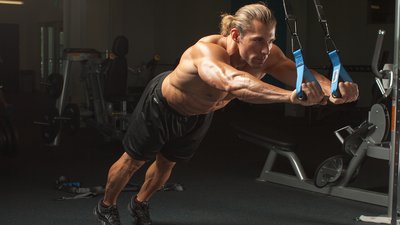Many compound lifters scoff at abdominal exercises and argue that heavy squats and deadlifts work the core sufficiently. I think this is a mistake. Sure, the core gets taxed during heavy compound movements, but it's often the hidden weak link and limiting factor that keeps lifters from reaching new PRs.
In other words, a stronger core inevitably leads to bigger lifts. If it helps, think of it this way: Squats and deadlifts work the glutes and hamstrings a hell of a lot, but most serious lifters still do supplemental posterior chain work. Why should the core be any different?
There's a catch, though. Crunches, basic planks, and side planks aren't going to provide the stimulus necessary for strong lifters to get stronger, because they're simply too easy. You need to challenge yourself with difficult, high-tension core exercises to see improvement across the board.
Here are eight demanding exercises to take both your abdominal strength and your overall strength to the next level!
Exercise 1 Iso Chin-Up Hold with Leg Raise
Generally I'm not a big fan of combination exercises, because one exercise is typically a lot harder than the other and you end up not being able to push yourself on the harder exercise. But here, both exercises are equally difficult, thereby allowing you to blast your upper back and core simultaneously.
People often cheat the heck out of hanging leg raises, usually by leaning way back, swinging, and creating momentum. This makes for a less than effective core exercise, and also leads to some significant spinal flexion. Holding the chin-up position helps prohibit backward lean, forcing you to be strict with the leg raises, which makes it safer and more effective.
Doing these with rings is especially great for stabilizing the body and keeping from swinging, but a bar works fine if you don't have access to rings. Don't lower your legs all the way down; stop 1-2 inches short to keep tension on the core. If it's too hard at first, hold the chin-up at mid-level and/or bend the legs to shorten the lever length.
Counting time can be difficult for this exercise unless you're positioned in front of a clock, so it's best to go for reps.
Exercise 2 Iso Chin-Up Hold with Dynamic L-Sit
I suck at naming exercises, so I normally just call these "spread 'ems" or "open sesames." No matter the title, it's a great exercise to challenge your core and upper back.
Hold the chin-up position, go into an L-sit position, and slowly open and close your legs while keeping the torso steady. Learning to resist swinging is one of the most challenge aspects of the exercise. The slower you go, the harder it is. Try to keep your legs as straight as possible.
You can also do these from the hang position if the chin-up hold is too tough. Like the chin-up iso-hold/hanging leg raise combo, it's usually best to do these for reps. Just make sure to wear loose shorts to avoid giving your fellow gym-goers a show they don't want.
Exercise 3 Iso Chin-Up Hold with L-Sit Flutter Kicks
This movement starts at the same point as the open sesame, but moves vertically rather than horizontally. Hold the chin-up position, enter an L-sit position, and perform small flutter kicks with your legs straight out. These are harder than the dynamic L-sit combo, so master that exercise first.
The goal is to keep your legs straight, but if you're unable to manage that initially, start with bent legs and progress to straightening them. Because the legs move quickly, it's tough to count reps, so it works better to do these for time. Start at 5-10 seconds and build up from there. That time will go by slower than you think!
Exercise 4 Iso Chin-Up Hold with L-Sit Leg Extension
I saved L-sit leg extensions for last because it's the hardest L-sit variation. Start by holding the chin-up position and extend your legs into an L-sit position. Bring your legs in, extend them straight out, and keep your torso steady to avoid swinging.
Put a medicine ball or dumbbell between your feet to increase the challenge. You can do these for reps or time.
Exercise 5 Single-Leg Plank Walk
Get in a push-up position with one foot on a Valslide or furniture slider and let the other foot hover just off the floor. From there, walk forward with your hands, keeping your arms as straight as possible, and keep your hips steady.
Walk as far as possible with one leg and switch legs on the way back. If you don't have space to walk, use a slide board to walk forward and backward for a set number of reps, and then switch legs. In either case, this exercise works your core and shoulders and jacks up your heart rate, which makes it a great finisher to an upper-body workout, either on its own or as part of a circuit with movements like battling ropes, sled pushes, or farmer's walks.
Exercise 6 Shoulder-Friendly Suspension Strap Fallout
The normal suspension strap fallout progression is to start with the straps around waist height and extend your body until your arms are directly overhead. As you improve, you lengthen the straps and extend out farther, progressing until the straps almost touch the floor, which resembles the starting position of a standing ab wheel rollout.
There's certainly nothing wrong with that progression, but for people with shoulder issues it can be problematic. To make it more shoulder-friendly, set up several feet behind the anchor point of the straps. This also makes the exercise significantly harder, because you don't have to extend your arms out nearly as far to challenge the core. The tension is more or less constant throughout the movement.
There isn't much range of motion at the arms, but this exercise lights the core up when done correctly. The farther you walk back, the harder it becomes. On the plus side, the farther you walk back the easier it becomes on the shoulders, but only walk back to a point where you can still control the movement. If you start to feel the exercise in your lower back, you've gone too far.
Perform this exercise for reps, and focus on progressively moving farther backward.
Exercise 7 Single-leg fallout
Single-leg fallouts decrease your support base, which makes the exercise harder and adds a rotary stability component. The normal fallout already does a great job at working the anterior core, so this wrinkle makes it even better at building all-around core strength. Like the shoulder-friendly fall-out, perform this exercise for reps and focus on progressively moving farther backward.
Exercise 8 Single-Leg Bodysaw
Regular bodysaws are great, and many people are surprised by just how difficult such a tiny range of motion can be. Once you've got that down, though, you can take it a step further by doing single-leg bodysaws. From there, if you feel frisky, try the single-arm, single-leg version, which challenges even the most advanced lifters.
Trying to count during this exercise is nearly impossible due to the intense strain throughout your body. Go for reps, and enjoy all the benefits your newfound core strength brings!


